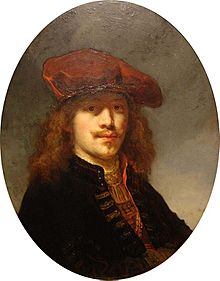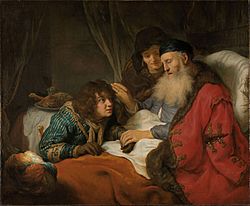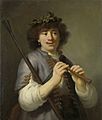Govert Flinck facts for kids
Quick facts for kids
Govert Flinck
|
|
|---|---|

Self-portrait, circa 1640, Oil on panel, 66 × 51.4 cm, Kelvingrove Art Gallery and Museum, Glasgow, Scotland
|
|
| Born |
Govert Teuniszoon Flinck
25 January 1615 |
| Died | 2 February 1660 (aged 45) |
| Nationality | Dutch |
| Education | Rembrandt van Rijn |
| Known for | Painting |
| Movement | Dutch Golden Age Baroque |
Govert Flinck (born January 25, 1615 – died February 2, 1660) was a famous Dutch painter. He lived during the time known as the Dutch Golden Age, when art and science in the Netherlands were very successful.
Contents
Life of Govert Flinck
Govert Flinck was born in Kleve, a city that was part of the Duchy of Cleves. At the time, this area was controlled by the Dutch Republic. His father wanted him to become a silk merchant. But Govert secretly loved to draw and etch.
Because of his passion for art, he was sent to Leeuwarden. There, he lived with Lambert Jacobsz, who was a Mennonite preacher and also a painter. In Leeuwarden, Flinck met Jacob Backer, another young artist. Their friendship made Flinck even more determined to become a painter.
Lambert Jacobsz lived near the family of Rombertus van Uylenburgh. Rombertus's daughter, Saskia, later married the famous painter Rembrandt in 1634. Other members of the Uylenburgh family lived in Amsterdam and were also interested in art.
Learning from Rembrandt
Flinck likely learned about Rembrandt through the Uylenburgh family. By 1637, people like Joachim von Sandrart recognized Flinck as one of Rembrandt's best students. Flinck even lived in the home of art dealer Hendrick van Uylenburgh in Amsterdam for a long time.
For many years, Flinck painted in Rembrandt's style. He followed his teacher's methods in all his works from 1636 to 1648. However, Flinck also wanted to be a history painter. This meant he wanted to paint large scenes from stories, myths, or history. For these, he looked to the grand style of Peter Paul Rubens. This led to many important jobs painting for officials and diplomats.
Flinck's connections to Kleve became very important. He met the Great Elector, Friedrich Wilhelm I of Brandenburg, who ruled the Duchy of Cleves. In 1646, the Elector married Louisa of Orange. Flinck also gained the support of John Maurice of Nassau, who became the governor of Cleves in 1649.
Later Life and Success
In 1652, Flinck became a citizen of Amsterdam. In 1656, he married Sophie van der Houven, whose father was a director of the Dutch East India Company. Flinck was already well-known among the wealthy families of Amsterdam. He was friends with important people like the poet Joost van den Vondel.
Flinck's house was filled with art, including copies of ancient sculptures and a large collection of prints. He often hosted important guests, including the governor John Maurice. Govert Flinck died in Amsterdam on February 2, 1660.
Famous Works by Govert Flinck
One of Flinck's earliest known paintings is a portrait of a lady from 1636, which is in the Brunswick gallery. His first major painting with a story is Blessing of Jacob (1638), found in the Rijksmuseum in Amsterdam. Both of these paintings show how much he was influenced by Rembrandt's style. They have strong colors and lively skin tones.
Flinck also painted many group portraits. His four civic guards from 1642 and the twelve musketeers from 1648 are great examples. These are in the Stadhuis, Amsterdam.
Key Paintings
One of Flinck's best group paintings is the peace of Münster in the Rijksmuseum. This large painting shows 19 life-size figures. Their faces are full of life, and the colors are bright, like Rembrandt's work. Flinck even included himself in this painting, on the left side in a doorway.
He also painted large historical scenes for the Palace on the Dam in Amsterdam. These include Marcus Curius Dentatus refuses the gifts of the Samnites and Solomon receiving Wisdom.
Other works by Flinck that you can see in public galleries include:
- The Grey Beard (1639) at Dresden.
- A Young Archer (1640) in the Wallace Collection.
- The Girl (1641) at the Louvre.
- A portrait group of a man and woman (1646) at Rotterdam.
- A lady (1651) at Berlin.
In November 1659, the city of Amsterdam asked Flinck to paint 12 large canvases. These were meant to show heroic figures like David and Samson, and scenes from the history of the Batavians and Romans. Sadly, Flinck died before he could finish these paintings. After his death, Rembrandt was asked to complete one of the commissions. He painted his last great history picture, The Conspiracy of Claudius Civilis, but the city authorities did not accept it.
Flinck also received praise from the town council of Kleve. He completed a painting of Solomon for them, which was similar to his work in Amsterdam. Many of his other paintings and portraits for the Great Elector, such as those of Friedrich Wilhelm and John Maurice, have been lost. However, the Expulsion of Hagar is still preserved in the Berlin museum.
Gallery
-
Rembrandt as shepherd with staff and flute
-
Landscape with Obelisk. Historically mistaken as being by Rembrandt. It was stolen in 1990 from the Isabella Stewart Gardner Museum. Boston.
See also
 In Spanish: Govert Flinck para niños
In Spanish: Govert Flinck para niños









